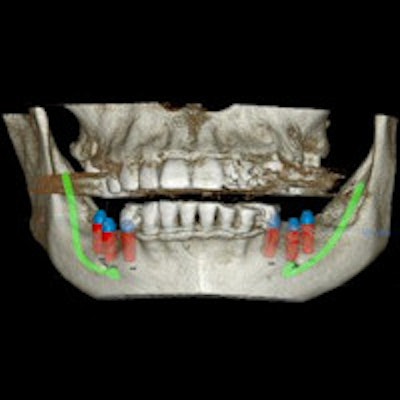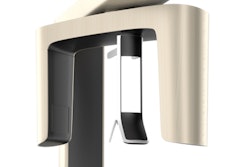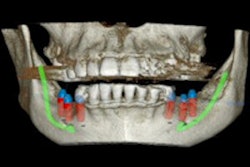
A new review in Dental Clinics of North America that examined current knowledge about the use of cone-beam CT (CBCT) in detecting early implant failures has found that, while it may have its uses, conventional radiographs will provide the necessary information in most cases.
The review focused on the most recent literature on the role of CBCT in detecting early implant failure, lead study author Juan Yepes, DDS, MD, MPH, DrPH, from the department of pediatric dentistry at the Indiana University School of Dentistry, told DrBicuspid.com.
Dr. Yepes added that this is a hot topic, and their article is one of the few, if not the first, that reviews it.
 Juan Yepes, DDS, MD, MPH, DrPH.
Juan Yepes, DDS, MD, MPH, DrPH.CBCT is widely used in preimplant assessment of anatomy, implant placement, visualization of important anatomic structures, assessment of bone mineral density, and, recently, early assessment of implant failure, the authors noted. Integration and postoperative complication are the two areas where cross-sectional imaging is used to evaluate implant success, they wrote (Dent Clin North Am, January 2015, Vol. 59:1, pp. 41-56).
Yet, CBCT has some of the same limitations inherent to all imaging modalities, Dr. Yepes and his colleague noted in the review.
"The most important limitations for implant planning are the lack of accurate representation of soft-tissue structures, such as the gingiva, and the various artifacts produced primarily by metal restorations; such artifacts may interfere with the diagnostic process masking underlying structures," they wrote.
The cost of CBCT is higher than that of other traditional modalities, and CBCT has also introduced the issue of liability in interpreting the image, they added.
"CBCT is increasingly being performed by dentists who do not have training in interpreting the image beyond what they see frequently or are familiar with," they wrote. "The dentists assume liability in reading and interpreting all of the anatomy of the entire CBCT image."
Also, the radiation exposure with CBCT is higher than that associated with traditional radiographs.
They discussed a study that used dogs to look at the accuracy of CBCT in determining buccal-wall configuration and regeneration of peri-implant bone defects after alveolar bone augmentation (Clinical Oral Implants Research, Vol. 23:7, pp. 882-887).
"The evaluation of peri-implant bone defect regeneration by means of CBCT is not accurate for sites providing a horizontal bone width of < 0.5 mm," the authors of that study concluded.
Another clinical study evaluated by the authors looked at whether CBCT could be used to measure buccal alveolar bone changes one year after implant placement (International Journal of Oral & Maxillofacial Implants, September 2012, Vol. 27:5, pp. 1249-1257).
“There is a limitation of the technology for the detection of implant failure.”
"When the implant was appropriately displaced from the buccal wall of the socket, bone changes could be qualitatively evaluated by CBCT one year following placement," the researchers of that study reported.
An in vitro study used bovine ribs to compare the diagnostic accuracy of conventional periapical radiographs and CBCT in detecting peri-implant bone defects. The results showed that that digital periapical images (using a long cone) were better in diagnosing peri-implant bone defects when the bone defect was smaller than 0.35 mm, while no significant difference was seen in cases in which the bone defect was larger than 0.675 mm (Clinical Oral Implants Research, 2013, Vol. 24:6, pp. 671-678).
"Within the limitations of this study, digital long-cone periapical radiographs are a reliable and valid method of detecting circumferential peri-implant bone defects and performed significantly better than CBCT," the authors of that study concluded.
Another study discussed by the current study authors used pig mandibles to investigate the accuracy and quality of the representation of peri-implant defects by intraoral radiography, panoramic radiography, CT, and digital volume tomography (DVT) (Journal of Periodontology, July 2006, Vol. 77:7, pp. 1234-41).
"Overall, the CT and DVT scans displayed only a slight deviation in the extent of the peri-implant defects," the researchers of that study concluded. "Both radiographic imaging techniques permitted imaging of peri-implant defects in three planes, true to scale, and without overlay or distortion. The DVT scans showed the best imaging quality."
Dr. Yepes and his colleague noted that, based on the few available publications, traditional image modalities, such as periapical radiographs, bitewing radiographs, and panoramic radiographs, performed at least as well as CBCT when the goal is evaluating implant placement.
They stressed, however, that more studies are necessary to determine the actual role of CBCT in detecting early implant failure.
"Dentists are interested in learning the applications of CBCT in implantology," Dr. Yepes concluded. "This review looked at the early detection and confirmed that there is a limitation of the technology for the detection of implant failure."



















